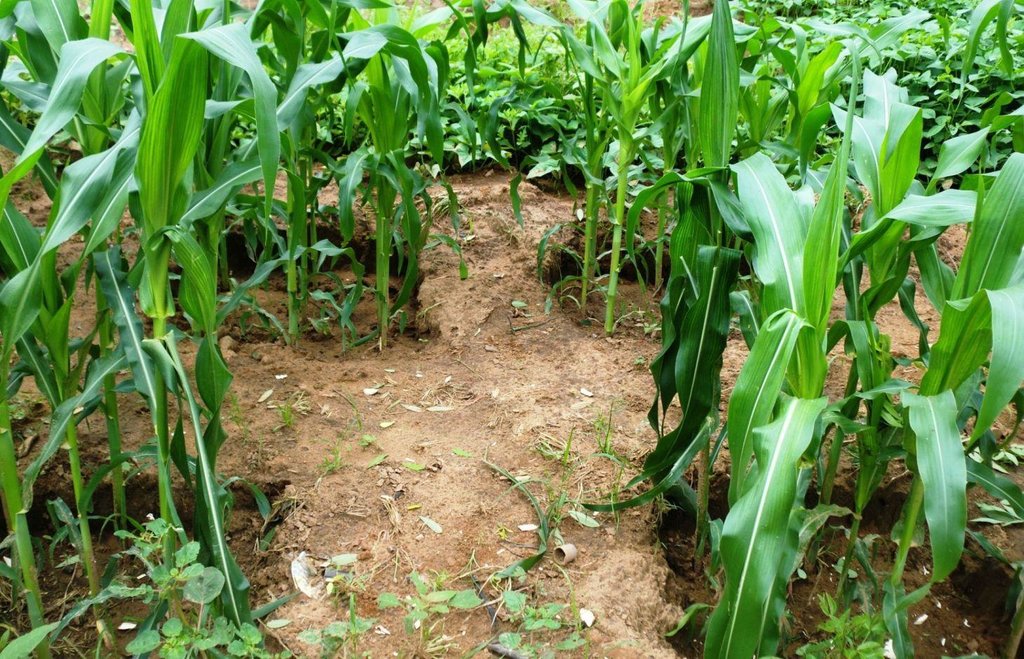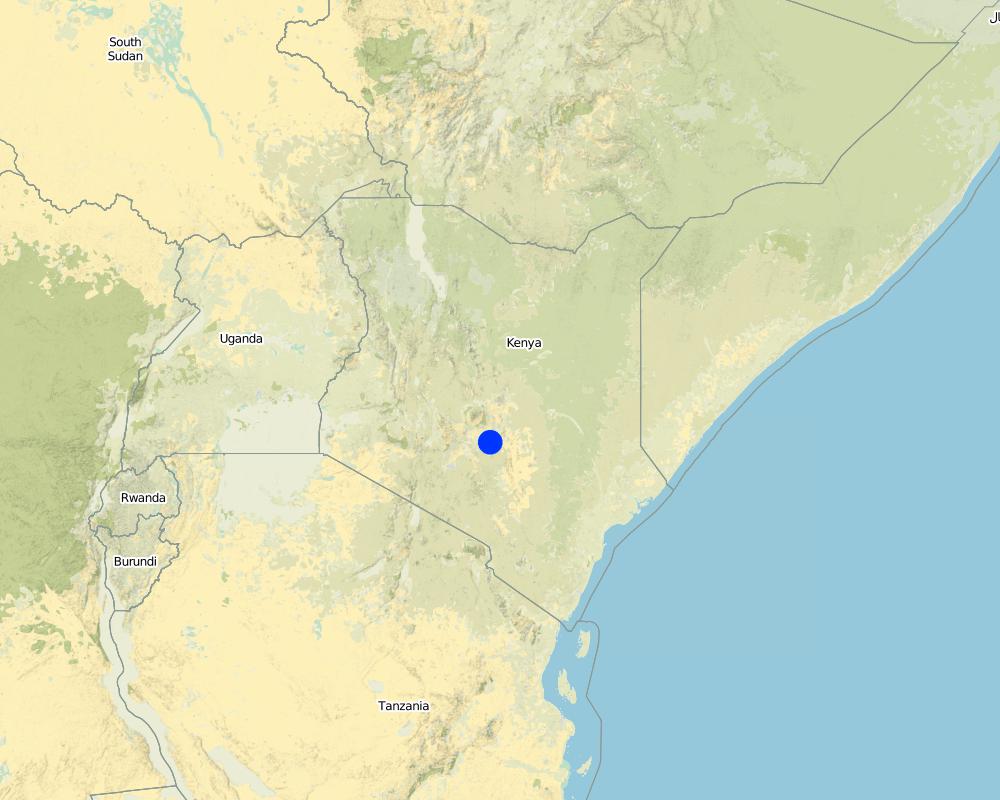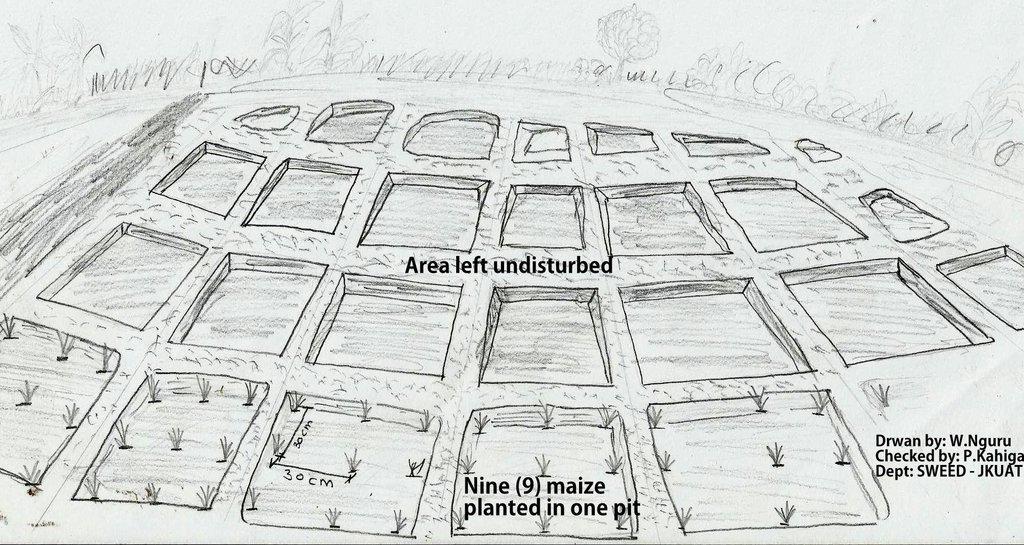Nine Maize Pits [肯尼亚]
- 创建:
- 更新:
- 编制者: Paul Kahiga
- 编辑者: –
- 审查者: Fabian Ottiger, Alexandra Gavilano
Maize Pits
technologies_1676 - 肯尼亚
查看章节
全部展开 全部收起1. 一般信息
1.2 参与该技术评估和文件编制的资源人员和机构的联系方式
SLM专业人员:
Gathenya Mwangi
Jomo Kenyatta University of Agriculture and Technology
肯尼亚
SLM专业人员:
Home Patrick
Jomo Kenyatta University of Agriculture and Technology
肯尼亚
SLM专业人员:
Chege Timothy
Jomo Kenyatta University of Agriculture and Technology
肯尼亚
SLM专业人员:
Abamba Omwange
Jomo Kenyatta University of Agriculture and Technology
肯尼亚
SLM专业人员:
Baobab Kimengich
Jomo Kenyatta University of Agriculture and Technology
肯尼亚
SLM专业人员:
Wamuongo Jane
Kenya Agricultural Research Institute
肯尼亚
SLM专业人员:
Karanja Andrew
Kenya Agricultural Research Institute
肯尼亚
SLM专业人员:
Namirembe Sara
World Agroforestry Centre (ICRAF)
肯尼亚
有助于对技术进行记录/评估的机构名称(如相关)
International Centre for Research in Agroforestry (ICRAF) - 肯尼亚有助于对技术进行记录/评估的机构名称(如相关)
KARI Headquarters (KARI Headquarters) - 肯尼亚有助于对技术进行记录/评估的机构名称(如相关)
Jomo Kenyatta University (Jomo Kenyatta University) - 肯尼亚1.3 关于使用通过WOCAT记录的数据的条件
编制者和关键资源人员接受有关使用通过WOCAT记录数据的条件。:
是
1.4 所述技术的可持续性声明
这里所描述的技术在土地退化方面是否存在问题,导致无法被认为是一种可持续的土地管理技术?:
否
2. SLM技术的说明
2.1 技术简介
技术定义:
The nine maize pits is a type of SLM technology whereby, a planting pits measuring (2*2*2) feet are dug along a contour and maize planted in the pit at a spacing of (30*30) cm. The top soil is mixed with FYM and the spaces in between are left un-ploughed.
2.2 技术的详细说明
说明:
Maize pits commonly referred as zai is a traditional land rehabilitation technology “invented” to rehabilitate degraded dry lands and to restore soil fertility to the benefit of farmers living there.They are made on land which is not very permeable so that runoff can be collected. Improvements in the traditional pits by the addition of organic matter (compost) have resulted in dramatic improvements in yield. The planting pits are suitable for semi-arid area like the lower Mbeere District to enable crops to survive dry spells. They are used on a wide variety soil types but most suitable on silt and clay soils where runoff can be generated due to limited permeability.
Purpose of the Technology: Apart from establishment of a nine maize crop stand in one pit, the technology assists in harvesting rain water, conserving the moisture, managing of soil fertility and controlling of weed development. Use of this technique in Mbeere South District have produced higher grain yields, particularly on highly degraded sandy soils. They offers a good potential to both increase the livelihood of the rural population and at the same time, combat desertification.
Establishment / maintenance activities and inputs: The process is started in dry season of the year. Holes of 2ft by 2ft and 2ft deep are dug out. Remove the top soil and put it on the uphill side. Remove the subsoil and place it down hill to form a continuous bund from end to end of each row. The top soil is returned into the pit and mixed with animal manure at the rate of 1 debe per hole. Plant 9 maize seeds on the pit at a spacing of 1foot. The compost can be made from rotted cow/sheep dung, leaves, and ashes from wood-fueled stoves.
Natural / human environment: These maize pits are usually constructed on abandoned or unused ground. Thus, crop yields resulting from this practice bring a benefit of 100%.
2.3 技术照片
2.5 已应用该技术的、本评估所涵盖的国家/地区/地点
国家:
肯尼亚
区域/州/省:
Eastern Province
有关地点的进一步说明:
Mbere South District
具体说明该技术的分布:
- 均匀地分布在一个区域
如果不知道精确的区域,请注明大致覆盖的区域:
- < 0.1 平方千米(10 公顷)
注释:
Practiced by many farmers with the assistance of an Agriculture extension officer from the ministry of Agriculture.
Map
×2.6 实施日期
如果不知道确切的年份,请说明大概的日期:
- 10-50年前
2.7 技术介绍
详细说明该技术是如何引入的:
- 通过土地使用者的创新
3. SLM技术的分类
3.1 该技术的主要目的
- 改良生产
- 减少、预防、恢复土地退化
- 适应气候变化/极端天气及其影响
- 创造有益的经济影响
3.2 应用该技术的当前土地利用类型

农田
- 一年一作
年作 - 具体指明作物:
- 谷物类 - 玉米
- 豆科牧草和豆类 - 豆子
每年的生长季节数:
- 1
具体说明:
Longest growing period in days: 90, Longest growing period from month to month: March to May
注释:
Major crop: Green grams / Maize
Major land use problems (compiler’s opinion): Crop water deficiency due to low soil moisture content
Major land use problems (land users’ perception): Inadequate water for the crop
Future (final) land use (after implementation of SLM Technology): Cropland: Ca: Annual cropping
3.3 由于技术的实施,土地使用是否发生了变化?
由于技术的实施,土地使用是否发生了变化?:
- 是(请在技术实施前填写以下有关土地利用的问题)

农田
- 乔木与灌木的种植
3.4 供水
该技术所应用土地的供水:
- 雨养
注释:
Water supply: Also post-flooding
3.5 该技术所属的SLM组
- 最小的土壤扰动
- 土壤肥力综合管理
- 集水
3.6 包含该技术的可持续土地管理措施

结构措施
- S2:堤、岸
3.7 该技术强调的主要土地退化类型

水质恶化
- Ha:干旱化
注释:
Main causes of degradation: soil management, Heavy / extreme rainfall (intensity/amounts), poverty / wealth, labour availability
Secondary causes of degradation: deforestation / removal of natural vegetation (incl. forest fires)
3.8 防止、减少或恢复土地退化
具体数量名该技术与土地退化有关的目标:
- 防止土地退化
- 修复/恢复严重退化的土地
4. 技术规范、实施活动、投入和成本
4.1 该技术的技术图纸
技术规范(与技术图纸相关):
The technical drawing on the right side shows a representation of how the nine maize pits are prepared. The top soil is put aside and mixed with FYM or other organic matter. The area in between the pits is left undisturbed.
Location: Mbeere South District. Eastern
Date: 19/09/2012
Main technical functions: control of raindrop splash, water spreading, sediment retention / trapping, sediment harvesting
Secondary technical functions: control of dispersed runoff: retain / trap, control of concentrated runoff: retain / trap
Retention/infiltration ditch/pit, sediment/sand trap
Vertical interval between structures (m): 0.2
Spacing between structures (m): 0.3
Depth of ditches/pits/dams (m): 0.2
Width of ditches/pits/dams (m): 0.3
Length of ditches/pits/dams (m): 0.3
作者:
Paul Kahiga, 62000-00200 Nairobi
4.2 有关投入和成本计算的一般信息
其它/国家货币(具体说明):
KSh
如相关,注明美元与当地货币的汇率(例如1美元=79.9巴西雷亚尔):1美元=:
100.0
注明雇用劳工的每日平均工资成本:
4.00
4.3 技术建立活动
| 活动 | 时间(季度) | |
|---|---|---|
| 1. | Land clearing | Before onset of rainfall |
| 2. | Digging of pits | Before onste of rainfall |
| 3. | Buying of seed maize | before onset of rains |
| 4. | Planting of seed maize | just before onset of rain |
4.4 技术建立所需要的费用和投入
| 对投入进行具体说明 | 单位 | 数量 | 单位成本 | 每项投入的总成本 | 土地使用者承担的成本% | |
|---|---|---|---|---|---|---|
| 劳动力 | Labour | ha | 1.0 | 24.0 | 24.0 | 100.0 |
| 设备 | Tools | ha | 1.0 | 15.0 | 15.0 | 100.0 |
| 植物材料 | Seeds | ha | 1.0 | 12.0 | 12.0 | 100.0 |
| 肥料和杀菌剂 | Manure (FYM) | ha | 1.0 | 50.0 | 50.0 | 100.0 |
| 技术建立所需总成本 | 101.0 | |||||
| 技术建立总成本,美元 | 1.01 | |||||
注释:
Duration of establishment phase: 1 month(s)
4.5 维护/经常性活动
| 活动 | 时间/频率 | |
|---|---|---|
| 1. | Weeding | after 2 months |
4.6 维护/经常性活动所需要的费用和投入(每年)
| 对投入进行具体说明 | 单位 | 数量 | 单位成本 | 每项投入的总成本 | 土地使用者承担的成本% | |
|---|---|---|---|---|---|---|
| 劳动力 | Labour (weeding) | ha | 1.0 | 24.0 | 24.0 | 100.0 |
| 设备 | Tools | ha | 1.0 | 15.0 | 15.0 | 100.0 |
| 技术维护所需总成本 | 39.0 | |||||
| 技术维护总成本,美元 | 0.39 | |||||
4.7 影响成本的最重要因素
描述影响成本的最决定性因素:
It requires high intensity labour due to manual construction.
5. 自然和人文环境
5.1 气候
年降雨量
- < 250毫米
- 251-500毫米
- 501-750毫米
- 751-1,000毫米
- 1,001-1,500毫米
- 1,501-2,000毫米
- 2,001-3,000毫米
- 3,001-4,000毫米
- > 4,000毫米
农业气候带
- 半干旱
Thermal climate class: tropics
5.2 地形
平均坡度:
- 水平(0-2%)
- 缓降(3-5%)
- 平缓(6-10%)
- 滚坡(11-15%)
- 崎岖(16-30%)
- 陡峭(31-60%)
- 非常陡峭(>60%)
地形:
- 高原/平原
- 山脊
- 山坡
- 山地斜坡
- 麓坡
- 谷底
垂直分布带:
- 0-100 m a.s.l.
- 101-500 m a.s.l.
- 501-1,000 m a.s.l.
- 1,001-1,500 m a.s.l.
- 1,501-2,000 m a.s.l.
- 2,001-2,500 m a.s.l.
- 2,501-3,000 m a.s.l.
- 3,001-4,000 m a.s.l.
- > 4,000 m a.s.l.
5.3 土壤
平均土层深度:
- 非常浅(0-20厘米)
- 浅(21-50厘米)
- 中等深度(51-80厘米)
- 深(81-120厘米)
- 非常深(> 120厘米)
土壤质地(表土):
- 中粒(壤土、粉土)
表土有机质:
- 中(1-3%)
如有可能,附上完整的土壤描述或具体说明可用的信息,例如土壤类型、土壤酸碱度、阳离子交换能力、氮、盐度等。:
Soil fertility: High
Soil drainage/infiltration: Good
Soil water storage capacity: High
5.4 水资源可用性和质量
地下水位表:
5-50米
地表水的可用性:
中等
水质(未处理):
不良饮用水(需要处理)
5.5 生物多样性
物种多样性:
- 中等
5.6 应用该技术的土地使用者的特征
生产系统的市场定位:
- 混合(生计/商业)
相对财富水平:
- 平均水平
个人或集体:
- 个人/家庭
机械化水平:
- 手工作业
性别:
- 女人
说明土地使用者的其他有关特征:
Land users applying the Technology are mainly common / average land users
Population density: 10-50 persons/km2
5.7 应用该技术的土地使用者使用的平均土地面积
- < 0.5 公顷
- 0.5-1 公顷
- 1-2 公顷
- 2-5公顷
- 5-15公顷
- 15-50公顷
- 50-100公顷
- 100-500公顷
- 500-1,000公顷
- 1,000-10,000公顷
- > 10,000公顷
这被认为是小规模、中规模还是大规模的(参照当地实际情况)?:
- 小规模的
5.8 土地所有权、土地使用权和水使用权
土地所有权:
- 个人,未命名
土地使用权:
- 个人
用水权:
- 个人
5.9 进入服务和基础设施的通道
健康:
- 贫瘠
- 适度的
- 好
市场:
- 贫瘠
- 适度的
- 好
6. 影响和结论性说明
6.1 该技术的现场影响
社会经济效应
生产
作物生产
生产故障风险
土地管理
注释/具体说明:
Machinery
收入和成本
农业收入
工作量
注释/具体说明:
High manpower to dig the pits
社会文化影响
食品安全/自给自足
SLM/土地退化知识
Food security and a source of income generation at household level
生态影响
水循环/径流
水的回收/收集
蒸发
土壤
土壤水分
6.2 该技术的场外影响已经显现
对邻近农田的破坏
对公共/私人基础设施的破坏
6.3 技术对渐变气候以及与气候相关的极端情况/灾害的暴露和敏感性(土地使用者认为的极端情况/灾害)
渐变气候
渐变气候
| 季节 | 增加或减少 | 该技术是如何应对的? | |
|---|---|---|---|
| 年温度 | 增加 | 好 |
气候有关的极端情况(灾害)
气候灾害
| 该技术是如何应对的? | |
|---|---|
| 干旱 | 好 |
注释:
Increase the depth of the pit for high water retention to enable drought tolerance
6.4 成本效益分析
技术收益与技术建立成本相比如何(从土地使用者的角度看)?
短期回报:
积极
长期回报:
积极
技术收益与技术维护成本/经常性成本相比如何(从土地使用者的角度看)?
短期回报:
积极
长期回报:
积极
6.5 技术采用
在所有采用这项技术的人当中,有多少人是自发的,即未获得任何物质奖励/付款?:
- 91-100%
注释:
100% of land user families have adopted the Technology without any external material support
There is a moderate trend towards spontaneous adoption of the Technology
6.7 该技术的优点/长处/机会
| 土地使用者眼中的长处/优势/机会 |
|---|
| Prevention of soil erosion. |
| It is a water harvesting technology. |
| 编制者或其他关键资源人员认为的长处/优势/机会 |
|---|
| Food security. |
| Prevention of excessive evaporation. |
| Income generation at household level. |
| Improves ground water recharge. |
6.8 技术的弱点/缺点/风险及其克服方法
| 土地使用者认为的弱点/缺点/风险 | 如何克服它们? |
|---|---|
| Encourages pests to stay in the pits |
| 编制者或其他关键资源人员认为的弱点/缺点/风险 | 如何克服它们? |
|---|---|
| Labour intensive (construction & maintenance) | |
| In wet seasons, they can be prone to water logging | |
| Prevents machinery movement in the farms |
7. 参考和链接
7.1 信息的方法/来源
- 实地考察、实地调查
- 与土地使用者的访谈
(现场)数据是什么时候汇编的?:
19/09/2012
链接和模块
全部展开 全部收起链接
无链接
模块
无模块






